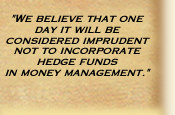November 10, 2008 – New York, NY – Hennessee Group LLC, an adviser to hedge fund investors, is consulting its clients on actions to take in the next five years for asset classes including hedge funds, bonds and precious metals. The Hennessee Group believes that while the Fed and Treasury are taking the necessary actions to remedy the current credit crisis and mitigate the risk of the worst recession in history, these actions have longer term collateral consequences. The stage is being set for a high inflationary period beginning the next three years. Charles Gradante, Co-Founder of the Hennessee Group, stated “a hyperinflationary period could be the next crisis on the horizon beginning in 2010 or 2011.” He further stated, “If the money supply continues to grow at its current pace, we could see inflationary levels similar to those experienced in the 1970’s once the current credit crisis begins to subside.” Specifically, Gradante believes money supply growth (M2) will exceed 12% in 2009, rivaling money supply growth of the 1970’s.
THE 1970’s AND INFLATION
Milton Friedman (a Nobel Prize Laureate in Economics) stated, “Inflation is always and everywhere a monetary phenomenon.” Inflation peaked at 12% in 1974 and 13% in 1979. Some attribute the inflation in the 1970’s largely to price shocks in oil (oil rose from $3 in 1970 to $40 in 1980) and the budget deficit of the Vietnam War era. Nonetheless, the Hennessee Group believes that the Fed’s easy money and credit policies served as the primary drivers for igniting inflation. Money supply growth peaked at an annualized rate of 12% in both 1972 and 1977 due in large part to an administration that was more concerned with maintaining low levels of unemployment rather than keeping inflation in check. The monetary policies of the 1970’s led to extremely high levels of inflation, forcing the Fed to quickly raise interest rates in order to reduce growth in money supply and reduce inflation. Ultimately, the Fed raised rates to 20% in 1980 which contributed to the 1981-82 recession with unemployment reaching 11%. The monetary policies in the 1970’s first led the U.S. into an environment of hyperinflation and then one of stagflation (a scenario whereby the economy experiences both rising price levels and slowing growth).
The investment environment during the 1970’s proved to be a great success or failure depending upon ones views. From an equity perspective, stocks suffered one of their worst bear markets in history with the Dow Jones Industrial Average losing nearly 50% of its value from 1973 to 1974. The most notable hedge against inflation in the 1970’s was gold, which rose from $106 in 1976 to $850 by 1980 (over $2,000 in 2008 on an inflation adjusted basis). Other precious metals, including platinum ($90 in 1970 to over $1000 in 1980) and silver ($2 in 1970 to $50 in 1980) rose strongly throughout the inflationary period as well. Non-precious metals such as copper rose from 53 cents in 1970 to 89 cents in 1980, after having risen to $1.06 in 1979. Agricultural commodities also experienced significant increases with wheat tripling in price.
1970’s ALL OVER AGAIN?
The Hennessee Group is concerned that the U.S. could end up in a similar scenario with the Fed and Treasury making it clear they will do whatever it takes to avoid further fallout from the credit crisis. “The Hennessee Group strongly agrees with former Federal Reserve Chairman Paul Volcker”, says Charles Gradante. Paul Volcker, whom ironically is credited for battling the double-digit inflation in the 1970s, recently made the following comments about the current economic situation, “The first priority is to stabilize the financial system. It is necessary even though the cost involved is heavy government intrusion in markets that should be private.” Volcker added, “It’s not going to be a problem in the short run. Inflation doesn’t flourish in the face of recession,” he said. “It’s something we have to worry about when we get out of this recession.”
While there has been a recent pullback in the price of oil and other commodities, as well as inflation in general, the Hennessee Group believes this is a short term correction in a longer term upward trend in inflation. A trend that could be exacerbated by the recent aggressive fiscal and monetary actions. The Fed has aggressively lowered interest rates in recent months and has injected a tremendous amount of liquidity into the market place, two notable actions being the $700 billion Troubled Asset Relief Program (TARP) and the recent Commercial Paper Funding Facility. As a result of these actions and several others, the money supply has been growing at an increasing rate in recent months. In total, the U.S. has lent out nearly $1 trillion in bailout money and some estimate this number could reach $2 trillion before the credit crisis comes to an end. Based on these estimates, the Hennessee Group believes the money supply could reach $8.6 trillion between June and August of 2009. Assuming M2 does reach $8.6 trillion between June and August of next year, the money supply would be growing on a year-over-year basis of approximately 13% (M2 in June of 2008 was $7.6 trillion). “Such a scenario could ultimately force the Fed to reverse course in monetary policy as they did in the late 1970’s by aggressively raising rates and removing liquidity from the market place.”, stated Charles Gradante. “As a possible consequence of these actions the U.S. could experience the worst of all economic conditions…stagflation”, added Charles Gradante.
Given this backdrop, the Hennessee Group believes commodities, namely gold and other precious metals, could serve as good hedges against inflation going forward, as they did in the hyperinflationary and subsequent stagflation days of the 1970’s. The Hennessee Group plans to analyze the hyperinflation and subsequent stagflation days of the 1970’s in further detail, specifically the effects the inflationary environment had on different asset classes and publish their research results in the coming weeks.
About the Hennessee Group LLC
Hennessee Group LLC is a Registered Investment Adviser that consults direct investors in hedge funds on asset allocation, manager selection, and ongoing monitoring of hedge fund managers. Hennessee Group LLC is not a tracker of hedge funds. The Hennessee Hedge Fund Indices® are for the sole purpose of benchmarking individual hedge fund manager performance. The Hennessee Group does not sell a hedge fund-of-funds product nor does it market individual hedge fund managers. For additional Hennessee Group Press Releases, please visit the Hennessee Group’s website. The Hennessee Group also publishes the Hennessee Hedge Fund Review monthly, which provides a comprehensive hedge fund performance review, statistics, and market analysis; all of which is value added to hedge fund managers and investors alike.
Description of Hennessee Hedge Fund Indices®
The Hennessee Hedge Fund Indices® are calculated from performance data reported to the Hennessee Group by a diversified group of over 1,000 hedge funds. The Hennessee Hedge Fund Index is an equally weighted average of the funds in the Hennessee Hedge Fund Indices®. The funds in the Hennessee Hedge Fund Index are derived from the Hennessee Group’s database of over 3,500 hedge funds and are net of fees and unaudited. Past performance is no guarantee of future returns. ALL RIGHTS RESERVED. This material is for general information only and is not an offer or solicitation to buy or sell any security including any interest in a hedge fund.












